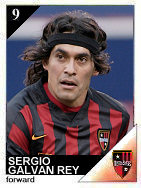The cursed #9
August 21, 2006
Sport curses. Weird, aren't they? We all know that there's nothing to them, yet fans often cling to them, and media often blow them up. Here in Metro land, we have the Curse of Caricola, and nothing short of a championship could wipe the Italian's own goal stain off this franchise. But let's consider another curse (and if one doesn't like that word, call it a hideous coincidence), that of the #9 jersey. What often is a glamour number on many of the world's teams is covered in Metro misery.
#9. The center forward. Gabriel Batistuta. Alan Shearer. Ronaldo. When the latter joined Inter Milan, Ivan Zamorano was asked to switch off #9, so his number became #18... except it was written on his jersey as "1+8". The list of great #9s in soccer history is long... as opposed to the list of great #9s in Metro history, which is nonexistent, and filled with misery and failure.
The original Metro #9 was Peter Vermes, who was also handed the captain's armband. Vermes lasted a year with the club, scoring just a single goal (although his shootout playoff winner will never be forgotten). Amazingly, if one has to pick the best #9 in club history, Vermes is still near top of the list, as it's all been mainly downhill from there.
 In 1997, Manny Lagos switched from #13 to #9, and promptly missed half of the season. In 1998, the number belonged to Marcelo Vega, one of the greatest busts (and greatest stomachs) in club's history. In 1999, it was left open, then given to Henry Zambrano, who scored three goals but was soon sent packing.
In 1997, Manny Lagos switched from #13 to #9, and promptly missed half of the season. In 1998, the number belonged to Marcelo Vega, one of the greatest busts (and greatest stomachs) in club's history. In 1999, it was left open, then given to Henry Zambrano, who scored three goals but was soon sent packing.
In 2000, with Lothar Matthaus demanding #10, Tab Ramos switched to #9, but clairvoyantly told MetroFanatic that he will be back to #10 sooner rather than later. The prophecy came true in a year, but Ramos' 2000 was his second best year with the club, as he played in 27 games in all competitions, scoring three goals and eight assists. But he was never a real #9; for him it was just a temporary switch.
In 2001, Alex Comas went from #23 to #9, and followed his 14-goal year with just two (one a penalty) in 13 matches, leading to his mid-season release. The number was taken over by Gilmar; the less said about him, the better. In 2002, #9 was given to Byron Alvarez. Somehow he has since carved himself a nice career in the USL, but will forever be remembered as one of the worst players in Metro history. There are not enough words in the dictionary to describe how horrible he was, so let's move on.
 In 2003, Jaime Moreno came with much fanfare and took his customary #9. He proceeded to tank the season, scoring two goals (one a penalty) in 11 matches and cried his way back to DC for 2004. Which led to the signing of Sergio Galvan Rey, the one-time "King of Goals" in Colombia, who arguably had the worst season for a striker in Metro history, with just two goals (one a penalty) in 23 matches. Of course, his 2005 was better, but not enough to erase the stench. But he did become the first Metro to wear the number for more than one season. In 2003, Jaime Moreno came with much fanfare and took his customary #9. He proceeded to tank the season, scoring two goals (one a penalty) in 11 matches and cried his way back to DC for 2004. Which led to the signing of Sergio Galvan Rey, the one-time "King of Goals" in Colombia, who arguably had the worst season for a striker in Metro history, with just two goals (one a penalty) in 23 matches. Of course, his 2005 was better, but not enough to erase the stench. But he did become the first Metro to wear the number for more than one season.
And in 2006, we've already had three #9s. Thiago Martins wore it for just 11 minutes before a trade for Jean-Philippe Peguero, who looked to be the man to break the curse, bursting out with a hat-trick in just his third game, and scoring six goals in his first seven matches. But of course, he is no longer with the team, sold to Denmark, and #9 now goes to John Wolyniec, in his fourth stint with Metro and on his third different number.
Where will #9 go from here? Are we finally due a true center forward or will the number be continued to be worn by underachievers and flops? Who knows... Of course, #4, #8, and #11 haven't fared much better, but those are stories for another time.
|
